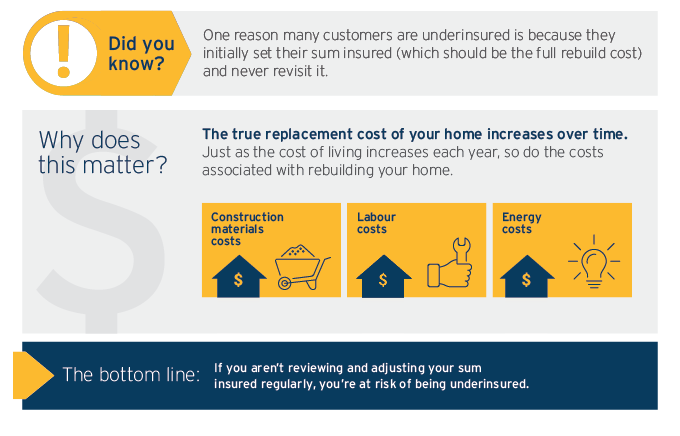

Understanding underinsurance —
are you at risk?

Your home is typically your most valuable asset, yet many homeowners are underinsured.
While some people are unaware that they are underinsured, it is your responsibility to ensure that you have accurately valued your home insurance coverage. Underinsurance often catches people off-guard when they come to make a claim.
When’s the last time you reviewed and updated your sum insured?

What are the consequences of underinsurance?
It is ultimately your responsibility to make sure that you are insured for the full replacement or rebuild cost. If you don’t, you might find yourself dealing with the following:
The percentage by which you are underinsured matters.
Underinsurance clauses are based on the principle that if you pay only a portion of the premium that you should be paying to fully cover your home or contents – then you can only receive back an equivalent proportion of any claim.
Consider the following scenario:
| Your true replacement costs | = | $1,000,000 |
| Your chosen sum insured | = | $500,000 |
| Percentage undervalued | = | 50% |
Your home is partially damaged in a windstorm and you make a claim for $250,000 for repairs. You would be paid:
| $250,000 (full claim amount) - 50% (percentage underinsured) = $125,000 (minus your deductible) |
Is true replacement cost the same as market value?
Not necessarily – there’s likely a considerable difference between market value and the true replacement cost of your home, which refers to the amount it would cost you to rebuild your home from the ground up if it were to be destroyed, including materials and labour. Market value represents the amount a potential buyer would be willing to pay to purchase your property in its current condition and takes other factors (like location) into consideration.
The difference between market value vs. true replacement value
| Market value | True replacement value |
|
|
|
|
|
|
|
|
|
|
|
|
|
|
|
Get your house in order – 5 ways to avoid being underinsured
How can Island Heritage help?
At Island Heritage we want to help our customers avoid costly and unpleasant surprises. Don't hesitate to get in touch so that we can help you assess whether you run the risk of underinsurance. We're here to help should you have any questions.
